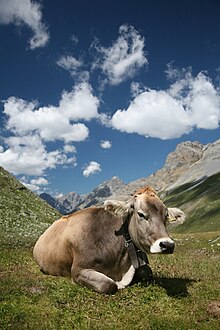Braunvieh
 | |
| Other names |
|
|---|---|
| Country of origin | Switzerland |
| Use | dairy |
| Traits | |
| Weight | |
| Height | |
| Notes | |
| originally a triple-purpose breed, for milk, meat and draught | |
| |
The Braunvieh (
In the latter part of the nineteenth century cattle of this type were exported to the United States, where they were
History
The Braunvieh derives from the grey-brown mountain cattle raised from
Braunvieh were shown at the
The Schwyz and two other breeds of Alpine brown cattle were recognised in 1875, and in 1879 the three were combined into a single herd book with the name Schweizerische Braunvieh.
Between 1967 and 1998 there was substantial
The Original Braunvieh
In Switzerland some breeders had continued to breed the traditional type of dual-purpose Braunvieh, and this was formalised as the Schweizer Original Braunvieh in 1993.[11] It is registered in the same herd book as the modern-type Braunvieh, but has different breeding aims. Efforts to preserve the original Braunvieh type had begun in Germany in 1988 with the formation of the Arbeitsgemeinschaft zur Erhaltung und Züchtung des Original Braunviehs im Allgäu.[9] In Italy it is known as the Bruna Italiana Vecchio Ceppo.[12]
In other countries
The Braunvieh has given rise to several European cattle breeds in the Alpine region, in Austria, in Germany, in Italy and in Spain, as well as the Brown Swiss in the United States.[5]: 19
The Montafon of the southern Vorarlberg of Austria was of medium weight, muscular, usually brown with a pale dorsal stripe. In 1923 the name was changed to Voralberger Braunvieh.[13]: 253
The
Braunvieh exported to the United States from about 1870 were bred exclusively for milk production, and developed into the modern American Brown Swiss.[10]: 11, 15
Characteristics

The Braunvieh is a uniform brown or grey-brown in color; the nose is black and encircled by a pale ring. The horns are pale with dark points. Cows weigh some 650–700 kg, with a height at the withers in the range 140–152 cm;[15]: 22 bulls weigh on average 1050 kg, with an average height of 152 cm.[1]
Use
The Braunvieh is a dairy breed. Depending on location, milk production ranges between 7200 (in mountain regions) and 12000 litres per year.[citation needed]
See also
- Brune (cattle breed)
References
- ^ a b c d e f Breed data sheet: Braunvieh / Switzerland (Cattle). Domestic Animal Diversity Information System of the Food and Agriculture Organization of the United Nations. Accessed November 2021.
- ISBN 9781789241532.
- ^ ISBN 9781780647944.
- ^ ISBN 9780760331927.
- ^ doi:10.3390/d6040705
- ^ Ludwig Wallrath Medicus (1795). Bemerkungen über die Alpen-Wirtschaft auf einer Reise durch die Schweiz (in German). Leipzig: Gräff; cited by Engeler.
- ^ Willy Engeler (1947). Das schweizerische Braunvieh: Monographie und Quellenwerk über die Braunviehrasse, ihre Verbreitung, Züchtung und Förderung in Geschichte und Gegenwart (in German). Frauenfeld: Huber.
- ^ a b [s.n.] (2012). Geschichte (in German; in English ). Schweizerische Braunvieh. Archived 4 March 2016.
- ^ a b c Wolfgang Kustermann (1994). Schwerpunkt - Rinder: Das Original Braunvieh (in German). Gesellschaft zur Erhaltung alter und gefährdeter Haustierrassen. Accessed October 2015.
- ^ a b Sophie Maria Rothammer (2011). Genomweite Detektion von Selektionssignaturen in divergent selektierten Rinderpopulationen mit anschließender Identifikation eines möglichen kausalen Gens (doctoral dissertation, in German). Ludwig-Maximilians-Universität München. Accessed October 2015.
- ^ [s.n.] (2012). Schweizer Original Braunvieh (in German). Schweizerische Braunvieh. Archived 21 April 2016.
- ^ Breed data sheet: Bruna Italiana Vecchio Ceppo/Italy. Domestic Animal Diversity Information System of the Food and Agriculture Organization of the United Nations. Accessed October 2015.
- ISBN 9789054390176.
- ^ ISBN 9788850652594. p. 9–11.
- ^ Tiergenetische Ressourcen der Schweizer Landwirtschaft (in German). Bern: Bundesamt für Landwirtschaft. Accessed January 2023.
